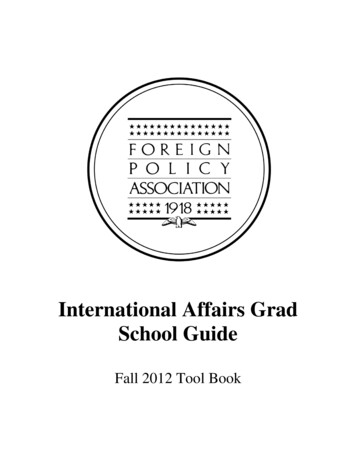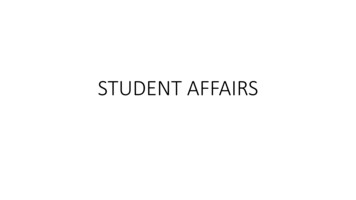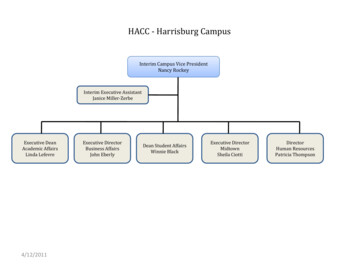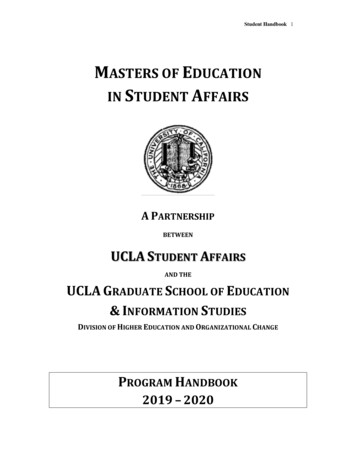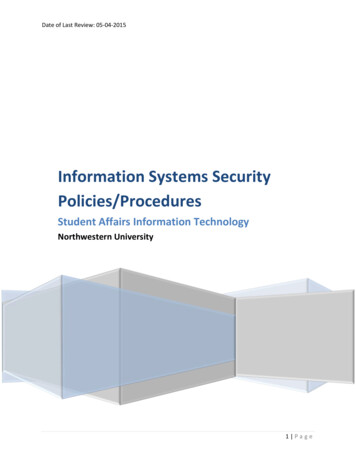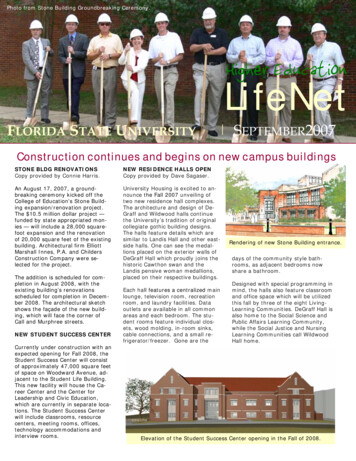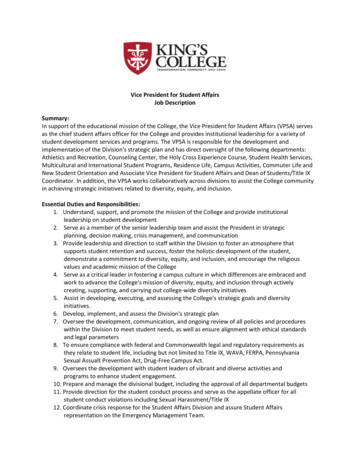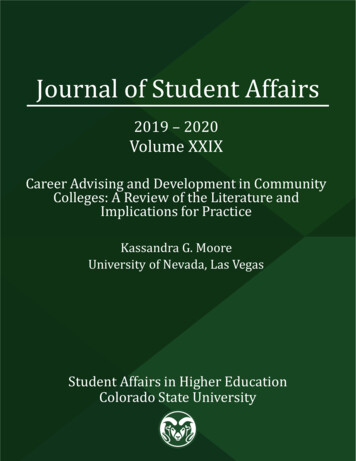
Transcription
Journal of Student Affairs2019 – 2020Volume XXIXCareer Advising and Development in CommunityColleges: A Review of the Literature andImplications for PracticeKassandra G. MooreUniversity of Nevada, Las VegasStudent Affairs in Higher EducationColorado State University
Career Advising and Development in Community Colleges 47Career Advising and Development in Community Colleges: AReview of the Literature and Implications for PracticeKassandra G. MooreUniversity of Nevada, Las VegasAbstractPreparing students for careers is a primary responsibility ofcollege administrators. However, career preparation can bechallenging at the community college level since studentsattend two-year institutions with diverse motivations participating in recreational courses, or enhancing their skillsand/or basic knowledge in a particular area of study. Withthe goal of understanding career advising and careerdevelopment for community college students, this literaturereview describes the current climate of career development atthe community college level, explores challenges thatcommunity colleges face in serving the diverse needs ofstudents in the area of career development and readiness, andprovides recommendations for effectively serving such adiverse body. This article concludes by discussing bestpractices and future research directions for supporting careerreadiness of community college students. It is important touse the information from this review to create best practicesfor effective career development initiatives at communitycolleges across the United States.Keywords: community college, career, career advising, careerdevelopmentThe community college system in the United States serves and educates adiverse population of students with unique purposes and motivations forattending. As such, student support services at the community college level arechallenged with providing appropriate and effective services to a diverse studentbody. Some common reasons why an individual might choose to attendcommunity college include: transferring to a four-year institution, vocational/jobtraining, recreational education, or enhancement of basic knowledge in an areaof study (Guthrie, 2016). According to Ma & Baum (2015), much of thecommunity college population does not fit a traditional college student profileas many work full-time, are over 25 years of age, or are academicallyunderprepared. In addition, Cadenas, Cantú, Spence, and Ruth (2018) bringawareness to the fact that community college in the United States is a highly
48 Journal of Student Affairs, Vol. XXIX, 2019 – 2020convenient and affordable option for minoritized, low-income, and nontraditional students. These underserved groups face unique barriers topersistence in higher education, which drastically impacts their career-goalachievement as well. Engaging with traditionally underserved groups presents aspecial set of barriers for adminstrators that need to be considered andrecognized when supporting community college students, such as challengesusing technology, getting to class, accessing resources outside of the classroom,and more (Cadenas et al., 2018). Combined, all of these factors drasticallyaffect a two-year institution’s ability to provide student support services thatmeet the needs of all students.One area significantly impacted by this reality of the community college settingis career development. At a four-year institution, it is common to see careercenters provide resources for career development to their students, includingresume building, career counseling, job search assistance, mock interviewing,and networking, among other activities and services. However, less is knownabout the career development opportunities offered in the community collegesetting. This literature review seeks to better understand career advising in thecommunity college system in the United States and seeks to providerecommendations for practitioners in the field.When consideringrecommendations, it is important to look through the lens of social cognitivetheory, which suggests that creating an environment that emphasizes careerdevelopment is key for student success (Lent, Brown, and Hackett, 1994). Anoverarching question guiding this literature review is: What is the careeradvising experience like in community colleges? This inquiry prompts twoadditional questions for consideration: a) What challenges do career advisorsand advising centers face and b) What considerations need to be made whenserving a diverse student body in regards to career development at thecommunity college level?Overview of Career Advising Services in Community CollegesMost career advising focuses on aspects of career and professionaladvancement. Some institutions provide courses, seminars, and workshops totheir student body with the goal of reaching more students in one setting (Grubb,2001). Other institutions may choose to utilize advisors to participate in one-onone conversations with students on topics related to occupational opportunities,resumes, interviewing, and job-seeking tips (Grubb, 2001). These conversationsmay be performed by a career advisor and/or a dual-advisor, who are meant tosupport students in other areas of their development, such as personally oracademically (Ledwith, 2014). Some colleges take the initiative to integratecooperative approaches to career advising through curriculum with faculty toengage students in career-readiness in the classroom (Grubb, 2001). As ageneral rule, healthcare programs, such as nursing, engage in more career
Career Advising and Development in Community Colleges 49development than other programs (Grubb, 2001). Regardless of the platform forwhich career preparation manifests at the community college level, it isimportant to know that each institution is unique in their approach to careeradvising and development.Career Services CentersCommunity colleges may have career services offices on campus to providecareer support to students. Data is not collected regarding the existence of and/orinteractions between career centers at two- or four-year colleges. This makes itchallenging for practitioners to understand what is needed, as it is unclear whatthe current climate looks like for career services in higher education. However,navigation through community college career services websites suggests thatsome of the services offered include: a job board for job/internship postings,career counseling, mock interviews, resume and cover letter assistance, jobsearch resources, and career fairs. In these spaces on campus, staff offerresources to students interested in engaging in career development. An exampleof a community college career services center is at the College of SouthernNevada (CSN) in Las Vegas, Nevada. The CSN Career and Transfer Servicesoffice works in collaboration with their ReEntry program, which consists of sixfull-time staff members serving in various capacities, to aid students returning toschool and/or facing barriers to education or employment (“Career and TransferServices,” n.d.). In surveying different institutions’ websites and career centerwebpages, it is evident that most offices offer the same common resources, suchas resume reviewing, job fairs, career counseling, and more. For example,according to the Pasadena City College Career Center website, they offer verysimilar services, including meeting individually with a career specialist tofacilitate these career development activities (“How to Explore Majors &Careers,” n.d.).Major Challenges Faced by Community College Career AdvisingCommon challenges faced by community college career services include staffconcerns, challenges related to students’ utilization of services, and data issues(e.g., collecting post-graduation salary and employment information). Thesechallenges are described below, as community colleges that are unable toaddress these challenges often struggle to provide appropriate resources tostudents.Staff ConcernsCommunity colleges are significantly understaffed and lack financial resourcesto support student services (Langen, 2011). According to a study conducted byLangen (2011), as many as 91 percent of community college staff are classifiedas part-time. With such a small pool of full-time employees to train on careerdevelopment, there is a challenge in offering career advising to community
50 Journal of Student Affairs, Vol. XXIX, 2019 – 2020college students. Services that are most often understaffed and under-resourcedare typically related to career advising (Grubb, 2001). Many advisors who getthe chance to work with students one-on-one at community colleges are oftenoverworked with large caseloads that stymie their ability to best support theirstudents (National Association of Colleges and Employers Staff [NACE], 2017).In fact, according to the 2016-2017 Career Services Benchmark Survey Reportfor Colleges and Universities, the mean number of students per staff member atthe associate degree level was 6,068 compared to 1,689 at the bachelor’s degreelevel (NACE Staff, 2017). In many of these advisor-student interactions, thefocus is placed on academic advising, which relegates career development to asecondary priority (Grubb, 2001). One way to avoid this would be to implementmore career-readiness training for advisors to encourage them to actively thinkmore about career preparation when engaging with their students. In addition tothese staffing challenges, it seems that many community colleges are strugglingto find professionals to assist students in career-readiness (Langen, 2011).Career development is a topic in student affairs practice which requiresincreased attention at the community college level in the United States.Utilization of ResourcesResearch suggests that when career and professional development resources areprovided to students in community colleges, students are not utilizing them(Grubb, 2001; Harlow & Bowman, 2016). Furthermore, those who significantlyneed these resources are less likely to engage with career services. Students useguidance and counseling differently and at differing capacities, often leavingthose who really need them the most unable to capitalize on the resourcesoffered to them (Grubb, 2001). In the early part of the century, communitycollege students reported having low opinions of their career and academicadvising centers (Grubb, 2001). Further, even if students do utilize resources,their needs are so diverse that it becomes quite challenging to fit the needs of allstudents through advising measures. Community college students also enroll ina higher percentage of online courses compared to four-year college students,which means advisors are more likely to serve a commuting population who areless likely to be physically on campus (Lederman, 2018). Suggestions toaddress these challenges could be to integrate career development intocurriculum through engagement in focused assignments/activities in theclassroom to support more students across disciplines and with varyingidentities. This practice may make it more convenient or accessible forcommuting and online students to access career education information.Data ChallengesTracking progress and/or collecting data is a challenge experienced bycommunity college career services professionals. First Destination Survey(FDS) data is one of the most utilized forms of identifying career-attainment at
Career Advising and Development in Community Colleges 51higher education institutions. These surveys provide evidence related to astudent’s placement after obtaining a degree/credential from an institution. Forinstance, this data may indicate how many students are employed full-time orpart-time, pursuing service/volunteer opportunities, furthering their education, oreven joining the military, and is crucial in understanding how an institution ispreparing their students for life after college. Collecting this data in communitycolleges is challenging for several reasons. First, not all students who take acommunity college course intend to complete a degree. Second, certificateprograms do not have the same evaluation and outcome measures, which makeit difficult to track and compare data. Third, some students who start at acommunity college do not complete a degree or credential before transferring,which means they are not included in FDS results, giving community collegesan inaccurate estimate of students who attend community college for transferpurposes (Guthrie, 2016). An example of a student who may not be included inthis survey is a student who transfers to a four-year college or drops out beforemeeting degree requirements. Tracking students’ career progression and nextsteps is a major hurdle in addressing the issues related to career advising. Itmight be beneficial for community college professionals to create a survey thatprovides students the opportunity to report a variety of post-attendance plans,such as transferring to a four-year institution, career obtainment, and other plans,encouraging more helpful data.Considering DiversityIt is evident that community college students are very diverse. When consideringthe identities of students, approaches for career readiness and preparation likelyneed to manifest differently. Considerations related to race, ethnicity, and firstgeneration status is explored in the following sections to further understand theunique challenges faced by students engaging in career development at thecommunity college level.Racial & Ethnic ConsiderationsSupporting underserved, minoritized, and non-traditional students, who make upa large percentage of the community college population, can create specificchallenges within career preparation and advising. Teng, George, and Anderson(2001) suggest “community college career counseling providers should besensitive to the ethnic and age backgrounds of students in assisting them toidentify their career goals, type of career plans, and utilization of careerpreparation action as related to attending career related lectures” (p. 125). Thismeans that practitioners are encouraged to provide unique and equitable careerrelated opportunities to students of racial/ethnic minority groups. Onesuggestion to ensure sensitivity to the backgrounds of each student is by offeringspecific workshops on career education to students based on their identity (Tenget al., 2001). For example, providing workshops focused on supporting NativeAmerican students could help improve equity and effectiveness of career-related
52 Journal of Student Affairs, Vol. XXIX, 2019 – 2020services. Individualization allows students to feel more supported in theircareer development. Another suggestion is to partner minority students with afaculty mentor, as studies report minority students are more likely to persistwhen they engage with faculty at their institution (Stebleton & Diamond, 2018).Offering targeted interventions and connections with faculty or career mentorsof the same race can help to support minority students navigate their careeraspirations.Providing equitable opportunities for all students to be successful in their careeradvising experiences, regardless of race or ethnicity, is critical. This practiceadheres to the universal mission of community colleges, which is to serve andsupport students in their academic and career pursuits no matter what their goalsare. The benefits of same-race matching of faculty/career mentors andfacilitating individualized workshops prove to be invaluable in providingequitable career education opportunities to minoritized groups at the communitycollege level.First-Generation StudentsFirst-generation students face specific barriers that not all traditional collegestudents experience. For instance, first-generation students often lack thegeneral understanding of college processes, including financial aid, classregistration, tuition and fee payments, advising, and program selection. Amongthese, career readiness is often a challenge for many first-generation students,especially in community colleges (Grubb, 2001). For example, a student whocomes from an immigrant family may be unfamiliar with basic college processesand occupational opportunities (Grubb, 2001). With such little understandingand preparedness, community college practitioners must consider working indifferent ways to support first-generation students. Stebleton (2018) even foundthat first-generation students are least likely to say they used career services attheir institution. Data recognizes that first-generation students are not usingcareer advisors, thus it is important to be intentional about providing support tothis subgroup. Creating programs geared directly toward first-generationstudents might be a good place to start.Recommendations for Community College Career ServicesThis literature review has demonstrated that career development and advising incommunity colleges is important but challenging for a number of reasons. Thefollowing practical applications are derived from the literature and offerdirection and recommendations to community college career professionals. Toinform this discussion, the social cognitive career theory, in which careeraspirations are influenced by one’s environment, will be used as a framework(Lent, Brown, and Hackett, 1994). These recommendations are based on the
Career Advising and Development in Community Colleges 53goal that, to be successful, community colleges must create spaces for studentsto actively and openly plan for their careers.Career Pathways ProgramsCommunity colleges have created unique ways to incorporate career andprofessional development into the student experience. One way is throughcareer pathways programs, in which students engage in career-related activities,which are directly built into curriculum and instruction (Bragg & Krismer,2016). Going to class and completing coursework is arguably one of the onlythings that students are required to do to complete a degree or move onto theirnext step. Thus, a career pathways program is an innovative approach to careeradvising that makes participating in career development a requirement forstudents. Since it is considered a component of the curriculum, it can be a veryeffective way to engage in career exploration for community college students.Bragg and Krismer (2016) studied a career pathways program focused oncompetency-based principles that helped students secure and persist towardemployment opportunities through intensive support services related to careergoals. This practice helped to encourage and motivate students towards theirindividual career goals. Studies indicate that students in healthcare programs arelikely to benefit from an innovative approach like this, in which studentsparticipate in career development in the classroom (Bragg & Krismer, 2016).Guided PathwaysGuided Pathways is another potential approach to integrating careerdevelopment efforts into the community college student experience. GuidedPathways is a program that maps out academic programs for students in order tocreate a coherent pathway of study, premised on the idea that creating clearlydefined goals motivates students to persist toward their next step in career andacademic pursuits (Bailey, Jaggars, & Jenkins, 2015; Jenkins & Cho, 2013).Implementation of the Guided Pathways program has led to alignment withtransferring to a four-year institution and meeting requirements for occupationalprograms and career advancement (Jenkins & Cho, 2013). Essentially, GuidedPathways create a streamlined opportunity for students to more effectively andefficiently meet the goals and needs related to attending community college.According to Jenkins and Cho (2013), students who enter a program of study ina Guided Pathways approach are more likely to complete a credential (whichcan enhance their ability and chance of employment). Some Guided Pathwaysprograms even partner with a local four-year institution to guarantee transfer if astudent succeeds in their program, which contributes to advancing onto a fouryear college and creating more opportunity for career and professionaldevelopment (Jenkins & Cho, 2013). Through these programs, students areoffered additional student support services, such as integrated coaching andtutoring (Jenkins & Cho, 2013). This enhances a student’s ability to besuccessful and meet program needs, thus persisting to transfer to a four-year
54 Journal of Student Affairs, Vol. XXIX, 2019 – 2020institution, credential/degree completion, or job obtainment (Jenkins & Cho,2013). Both academic and career services units would be responsible forimplementation of this type of program, in that it both aligns with career andacademic development. This type of program could serve as a source forcollaboration among student affairs professionals at the community collegelevel, providing a unique career and academic development service to meet thediverse needs of community college students.Learning CommunitiesInstitutions may also enhance career development through effective andinnovative learning communities. The adoption of learning communities is atrending approach that creates an opportunity for students to persist throughdevelopmental education courses by working and collaborating within a learningcommunity. While learning communities do not have a direct focus on careerand professional development, they create a unique opportunity for students toengage with their peers and advisors to gain support, which improves theirchances of earning a credential (Minkler, 2002; Tinto, 2003; Weiss, Visher,Weissman, & Wathington, 2015). As mentioned earlier, earning a credentialenhances a student’s ability to identify and secure career/employmentopportunities. Horn and Skomsvold (2012) revealed that many communitycollege students indicate their goal is to achieve a bachelor’s degree or higher.A program that promotes student persistence to degree/credential completion ortransfer can also contribute to their career development, especially if there is athematic focus in the learning community. For example, having liberal artsstudents in the same learning community or engineering majors all in the samecommunity can be highly beneficial as it relates to student development andretention. Grubb (2001) encourages institutions to establish new and innovativeprograms, such as learning communities and occupational programs, to improvecareer development efforts on campus. For example, occupational faculty (whoserve as experts in a specific career field) may offer expert mentorship andadvising to enhance a student’s exposure to their career field and opportunities.Any approach that can enhance a student’s exposure to or understanding of aparticular career field is useful in their career development. While nottraditionally used for career development purposes, learning communities andoccupational programs can motivate students to complete their degree, whichincreases their career opportunities.Campus CollaborationWith very little funding and so many part-time staff, collaboration may be a wayto bolster career advising capacity on community college campuses. Across thenation, there are unique ways to collaborate across campus to promote careerdevelopment, and one common way is having advisors serve dual roles oncampus to students (Ledwith, 2014). For instance, sharing the role as a career
Career Advising and Development in Community Colleges 55and academic advisor may allow colleges to more adequately serve students andequip them for success. Creating a scenario in which a student can visit oneadvisor to meet both their academic and career needs is an effective strategy formeeting the unique demands of the community college population, in thatstudents are often full-time workers with other obligations outside of theircampus commitments (Ledwith, 2014). If a student can go to one advisor forboth a resume review and academic planning, they might be more likely to usetheir advisor and persist toward degree/credential completion or transfer.Institutions can support their staff in serving this dual role by encouraging themto research both career and academic development, attend webinars related tocareer and academic development, and engage in active self-assessment(Ledwith, 2014).Career and Professional Development ProgramsBuilding programs and creating opportunities for community college students toengage in career development is a creative and effective way to participate incareer advising. An evaluation of one program, the Career Placement Project,showed that participation in career development activities, including job-seekingskill development, job shadowing, career exploration, was positively associatedwith strong engagement in their career preparation (Norton & Field, 1998). Thisprogram is designed to provide tools and resources to students to promote theirchances of being career ready when they persist to their next step, whether it istransfer, job obtainment, or credential completion.Stebleton and Diamond (2018) discuss high-impact practices for careerdevelopment, in which faculty engagement plays a vital role in students’ careerreadiness and preparation. Specifically, first-year students as well as studentswith minoritized identities positively benefited from engagement with facultyand staff. Thus, this study encourages institutions to extend the opportunity toengage in career readiness through credit and non-credit courses, reimaginingthe role of career services at each unique institution, and embedding careerreadiness opportunities into the first-year experience through facultyengagement. In summary, “career-life planning and exploration during the firstyear of college would not only meet incoming students’ demands for support, itwould strengthen outcomes associated with overall student success, such asimproved sense of purpose and self-efficacy” (Stebleton & Diamond, 2018, p.161).Implications for PracticeIt is important to provide the opportunity to innovate and determine the bestpractices for supporting community college students in their career andprofessional development journeys regardless of their purpose for study, andregardless of whether their intention is transferring or career attainment. Thisliterature review highlights key areas that need to be improved. First, it may be
56 Journal of Student Affairs, Vol. XXIX, 2019 – 2020important that both structurally and socially, community colleges begin toemphasize career development as much as they tend to emphasize four-yeartransfer. Many community college students may feel pressured to pursue a fouryear institution and avoid career development because that is what they arepushed to do but what may not be the best for them. As higher educationadministrators, it is important to be supportive of all students’ educationalpursuits. Second, more support is needed for career services professionals andagents of change in the community college systems. Institutional agents arethose in an educational setting who are actively working to challenge systems(Stanton-Salazar, 2011). In this case, more resources should be directed towardsthose practitioners working to change the way career advising operates in thecommunity college system (Bensimon, 2007). Lastly, according to the socialcognitive career theory, career aspirations are influenced by one’s environment(Lent, Brown, and Hackett, 1994). Therefore, community colleges may seek tocreate spaces for students to actively and openly plan and discuss their careerdecisions. In addition, staff need to be provided advanced and interactivetraining to learn how to engage with a variety of students with varyingchallenges and opportunities. Both efforts would help to create a culture ofcareer preparation on campus, which can help to support community collegestudents in attaining their career goals.ConclusionCommunity colleges are systems of higher education that face unique challengesrelated to limited funding, lack of resources, and overworked staff, all whileserving a diverse student body with varying needs. Under these conditions, it ischallenging to find optimal ways to support students in their academic andcareer pursuits. However, community colleges need to be prepared to serve boththe first-generation student who identifies as African American studying nursingand the parent working full-time and is studying to complete an English as aSecond Language (ESL) certificate, among others. All students need to beprovided resources to achieve their career goals. Practical recommendationsinclude: career centers with more full- and part-time staff, joint academic andcareer counseling, Guided Pathways, the use of learning communities, facultyengagement, and more. Career advising and development at the communitycollege level needs increased attention, and it is the responsibility of highereducation administrators to marshal support for these important student serviceactivities.Kassandra Moore is a Career Coach at the University of Nevada, Las Vegas(UNLV) and a graduate of the Masters of Education in Higher Educationprogram at UNLV.
Career Advising and Development in Community Colleges 57ReferencesBailey, T., Jaggars, S. S., & Jenkins, D. (2015). What we know about guidedpathways: Helping students to complete programs faster. Researchoverview. Community College Research Center, Teachers College,Columbia University.Bensimon, E. M. (2007). The underestimated significance of practitionerknowledge in the scholarship on student success. The Review of HigherEducation 30(4), 441-469. doi:10.1353/rhe.2007.0032.Bragg, D. & Krismer, M. (2016). Using career pathways to guide studentsthrough programs of study. New Directions for Community Colleges,176, 63-72.Cadenas, G. A., Cantú, E. A., Spence, T., & Ruth, A. (2018). Integrating criticalconsciousness and technology in entrepreneurs
Nevada (CSN) in Las Vegas, Nevada. The CSN Career and Transfer Services office works in collaboration with their ReEntry program, which consists of six full-time staff members serving in various capacities, to aid students returning to school and/or facing barriers to education or employment ("Career and Transfer Services," n.d.).




